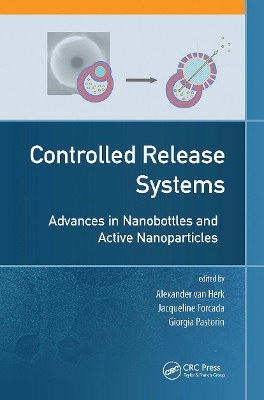
Controlled Release Systems
Pan Stanford Publishing Pte Ltd (Verlag)
978-981-4613-21-7 (ISBN)
Nanoparticles (including nanogels) that release their contents by external triggering open up new possibilities for therapeutic strategies. External triggering by light, heat, change in pH, or application of ultrasound opens up the possibility to release the material on demand. If only a part of the wall of the nanoparticle (nanocapsule) is responsive, we are dealing with the so-called nanobottles, a nanocontainer with the active substance and a lid on the container that can be "opened" and "closed" by external triggering.
This book focuses on responsive nanoparticles and brings together two interesting areas: nanoparticles and responsive polymers. The concept of the book is that of a systematic approach from nanoparticles synthesis via responsive polymers to nanobottles. The second part of the book presents contributions from experts in the field and provides a state-of-the-art overview of the field.
Jacqueline Forcada is associate professor in chemical engineering at the University of the Basque Country, Spain, and group leader at the Department of Applied Chemistry. Her research focuses on the synthesis, characterization, modeling, and biotechnological applications of functionalized polymeric and hybrid nanoparticles and nanogels. Alex van Herk is team leader and senior researcher at the Institute of Chemical and Engineering Sciences, Singapore, since 2012 and visiting professor in Polymer Reaction Engineering at the Eindhoven University of Technology, the Netherlands. His field of research is nanotechnology, water-based coatings, and emulsion polymerization. He has edited four books and authored more than 180 papers. Giorgia Pastorin joined the Faculty of Science at the National University of Singapore in June 2006, as assistant professor in the Department of Pharmacy. She became associate professor in the same department in July 2011. Her research interests focus on drug delivery (through the development of functionalized nanomaterials for potential biomedical applications) and medicinal chemistry (through the synthesis of heterocyclic molecules, as potent and selective GPCR ligands and potential therapeutics for several pathological conditions, including Parkinson’s disease and cancer.
Responsive Polymer Nanoparticles. General Introduction and Definitions. Responsive Polymers: Types and Properties. Types of Responsive Polymeric Nanoparticles and Comparison with Responsive Macroscopic Materials. Synthetic Strategies to Produce Responsive Polymer Nanoparticles. Approaches to Targeting of Nanoparticles towards Tissues/Organs. Characterization of Responsiveness. Selection of Nanoparticles for Treatment of Certain Diseases. State of the Art on Synthesis and Applications of Polymeric Nanoparticles. Nanogels. Magnetic Latex. Nanocapsules, Liposomes, Bubble Liposomes, Layer-by-Layer Approach, Micelles. Inorganic Nanoparticles/Capsules. Carbon Nanotubes. Dendrimers. Cancer. Neurodegenerative Diseases (Alzheimer, Parkinson). Nanocardiology. Immunotherapy and Vaccines.
| Zusatzinfo | 20 Illustrations, color; 75 Illustrations, black and white |
|---|---|
| Verlagsort | Singapore |
| Sprache | englisch |
| Maße | 152 x 229 mm |
| Gewicht | 932 g |
| Themenwelt | Medizin / Pharmazie ► Medizinische Fachgebiete ► Pharmakologie / Pharmakotherapie |
| Medizin / Pharmazie ► Physiotherapie / Ergotherapie ► Orthopädie | |
| Technik ► Maschinenbau | |
| Technik ► Medizintechnik | |
| ISBN-10 | 981-4613-21-5 / 9814613215 |
| ISBN-13 | 978-981-4613-21-7 / 9789814613217 |
| Zustand | Neuware |
| Haben Sie eine Frage zum Produkt? |
aus dem Bereich


